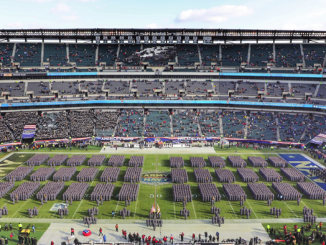
The three academies once again had three very different experiences on the gridiron this past week: Air Force soared, Army put up a good fight in defeat, and Navy tried hard but had more bad injury luck plus a few defensive breakdowns.
Let’s start with Air Force. The Falcons’ defense has seemingly put that 49-45 loss to Utah State in the rearview mirror, learning the right lessons from that failure and not having the lapses which were so abundant in that one game. The Falcons put together another strong defensive performance in a 24-17 win at Boise State. Air Force moved to 3-1 in the Mountain West. Colorado State is first in the Mountain Division at 2-0, but Air Force will be able to gain a head-to-head tiebreaker if it beats the Rams later this season. Moreover, Colorado State still has to play Boise State. The Rams still have six conference games left to play, whereas Air Force has only four. The Falcons pushed Boise State to 1-2 in the Mountain West. The Falcons have a two-game lead over the Broncos when including the head-to-head tiebreaker in the equation. Right now, Air Force should be seen as the favorite in the Mountain Division.
The defense carried the workload again.
In modern college football, scoring 24 points puts a team at great risk of losing. This isn’t the 1970s or early 1980s when offenses were more limited and the old “defense, field position, kicking game” mantra was more pervasive in the sport’s culture and tactics. Today, the proliferation of pass-first offenses with spread concepts has created a sport with higher scores and more challenges for defenses. Scoring just 24 points doesn’t offer a likely victory the way it might have in previous decades. Yet, it was enough for Air Force for the second straight week. The Falcons won 24-14 over Wyoming and now have another win with a modest 24-point showing from their inconsistent offense.
The biggest moment of drama in this game came after Boise State recovered a late onside kick. The Broncos are a tough out even in a struggle-bus season such as this one. Recovering the onside kick gave them a jolt of adrenaline. It would have been very easy in that moment for Air Force defenders to either become fearful or lose a measure of faith, if not both. Yet, right after the onside kick recovery, Boise State was stopped cold by Air Force’s defense. Tre Bug immediately intercepted Boise State quarterback Hank Bachmeier on first down. The BSU rally ended before it started.
This endgame performance by Air Force defense came after a fourth-and-goal stop from the 2-yard line earlier in the second half. The defense did the heavy lifting once again, showing that what was supposed to be the strength of this team in 2021 has in fact become its backbone.
“We really settled in after the first three series and made some big plays when we really needed them,” Air Force coach Troy Calhoun said after the game. “We were able to keep them out of the end zone and came up with some key stops, even at the end of the game to hold them to just a field goal.”
Air Force will probably need to score in the 30s at some point later this season to win a game, but there is no question that the defense has atoned for the Utah State fiasco, becoming a tower of strength in October.
Army didn’t win on the road in Madison against the Wisconsin Badgers, but the Black Knights certainly put up a good fight and reminded everyone that Power Five teams hate playing against them. Army held Wisconsin’s offense to just 13 points and had the ball near its own goal line late in the game with a chance to win. There was more than 3:30 left in the game, meaning that Army had enough time to run its normal offense and didn’t need to throw the ball. The game was winnable – maybe not a likely victory, but certainly within the realm of possibility. That’s all Jeff Monken could have realistically asked for. His defense stood up to Wisconsin in the trenches and showed the kind of staying power which has marked the past several years of highly successful football in West Point.
Army’s dream died, though, when Wisconsin’s Leo Chenal got into the backfield for a sack and a forced fumble the Badgers recovered inside the Army 5-yard line. The Badgers were in trouble, but that play by Chenal led to a touchdown and a 20-7 lead. Army – never giving up the fight – drove down the field for a last-minute touchdown, but Wisconsin recovered the ensuing onside kick and won 20-14. Army won more respect. It just wasn’t able to win the game as well.
Navy had more brutal injury luck on Thursday against Memphis. Quarterback Tai Lavatai got knocked out with an injury, and the Midshipmen – who produced a touchdown drive of over 11 minutes earlier in the game – allowed big-play passes to a Memphis team which had lost to Temple and Tulsa. The pieces simply didn’t fit for a Navy team which showed quality at times but is still falling short in its quest to produce a complete 60-minute game this season.
The coming week is filled with challenges for the service academies. Air Force gets ready for a big Mountain West showdown against West Division leader San Diego State. The Aztecs are unbeaten. Air Force will try to deal Team Tenochtitlan its first loss of the year.
Army hosts Wake Forest, another unbeaten team. The Demon Deacons are 6-0 for the first time since 1944. Army will try to knock off Dave Clawson’s overachieving squad, which is pursuing an ACC championship but will take a nonconference detour to West Point.
Navy hosts Cincinnati, ranked third in the country and pursuing a College Football Playoff berth. Navy’s November schedule is manageable, but this is one more especially difficult challenge for an undermanned group of Midshipmen.




Be the first to comment